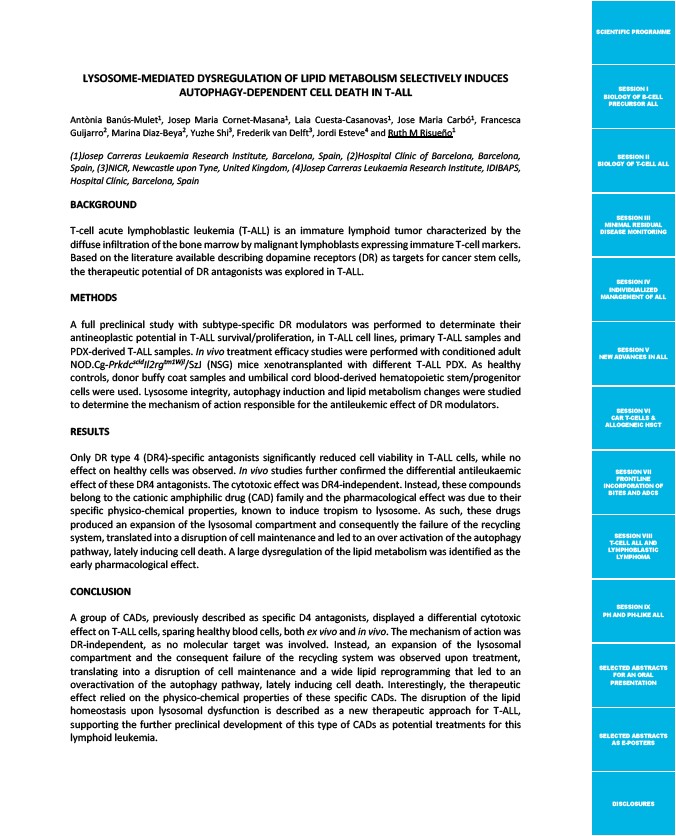
SCIENTIFIC PROGRAMME
SESSION I
BIOLOGY OF B-CELL
PRECURSOR ALL
SESSION II
BIOLOGY OF T-CELL ALL
SESSION III
MINIMAL RESIDUAL
DISEASE MONITORING
SESSION IV
INDIVIDUALIZED
MANAGEMENT OF ALL
SESSION V
NEW ADVANCES IN ALL
SESSION VI
CAR T-CELLS &
ALLOGENEIC HSCT
SESSION VII
FRONTLINE
INCORPORATION OF
BITES AND ADCS
SESSION VIII
T-CELL ALL AND
LYMPHOBLASTIC
LYMPHOMA
SESSION IX
PH AND PH-LIKE ALL
SELECTED ABSTRACTS
FOR AN ORAL
PRESENTATION
SELECTED ABSTRACTS
AS E-POSTERS
DISCLOSURES
LYSOSOME-MEDIATED DYSREGULATION OF LIPID METABOLISM SELECTIVELY INDUCES
AUTOPHAGY-DEPENDENT CELL DEATH IN T-ALL
Antònia Banús-Mulet1, Josep Maria Cornet-Masana1, Laia Cuesta-Casanovas1, Jose Maria Carbó1, Francesca
Guijarro2, Marina Diaz-Beya2, Yuzhe Shi3, Frederik van Delft3, Jordi Esteve4 and Ruth M Risueño1
(1)Josep Carreras Leukaemia Research Institute, Barcelona, Spain, (2)Hospital Clínic of Barcelona, Barcelona,
Spain, (3)NICR, Newcastle upon Tyne, United Kingdom, (4)Josep Carreras Leukaemia Research Institute, IDIBAPS,
Hospital Clínic, Barcelona, Spain
BACKGROUND
T-cell acute lymphoblastic leukemia (T-ALL) is an immature lymphoid tumor characterized by the
diffuse infiltration of the bone marrow by malignant lymphoblasts expressing immature T-cell markers.
Based on the literature available describing dopamine receptors (DR) as targets for cancer stem cells,
the therapeutic potential of DR antagonists was explored in T-ALL.
METHODS
A full preclinical study with subtype-specific DR modulators was performed to determinate their
antineoplastic potential in T-ALL survival/proliferation, in T-ALL cell lines, primary T-ALL samples and
PDX-derived T-ALL samples. In vivo treatment efficacy studies were performed with conditioned adult
NOD.Cg-PrkdcscidIl2rgtm1Wjl/SzJ (NSG) mice xenotransplanted with different T-ALL PDX. As healthy
controls, donor buffy coat samples and umbilical cord blood-derived hematopoietic stem/progenitor
cells were used. Lysosome integrity, autophagy induction and lipid metabolism changes were studied
to determine the mechanism of action responsible for the antileukemic effect of DR modulators.
RESULTS
Only DR type 4 (DR4)-specific antagonists significantly reduced cell viability in T-ALL cells, while no
effect on healthy cells was observed. In vivo studies further confirmed the differential antileukaemic
effect of these DR4 antagonists. The cytotoxic effect was DR4-independent. Instead, these compounds
belong to the cationic amphiphilic drug (CAD) family and the pharmacological effect was due to their
specific physico-chemical properties, known to induce tropism to lysosome. As such, these drugs
produced an expansion of the lysosomal compartment and consequently the failure of the recycling
system, translated into a disruption of cell maintenance and led to an over activation of the autophagy
pathway, lately inducing cell death. A large dysregulation of the lipid metabolism was identified as the
early pharmacological effect.
CONCLUSION
A group of CADs, previously described as specific D4 antagonists, displayed a differential cytotoxic
effect on T-ALL cells, sparing healthy blood cells, both ex vivo and in vivo. The mechanism of action was
DR-independent, as no molecular target was involved. Instead, an expansion of the lysosomal
compartment and the consequent failure of the recycling system was observed upon treatment,
translating into a disruption of cell maintenance and a wide lipid reprogramming that led to an
overactivation of the autophagy pathway, lately inducing cell death. Interestingly, the therapeutic
effect relied on the physico-chemical properties of these specific CADs. The disruption of the lipid
homeostasis upon lysosomal dysfunction is described as a new therapeutic approach for T-ALL,
supporting the further preclinical development of this type of CADs as potential treatments for this
lymphoid leukemia.